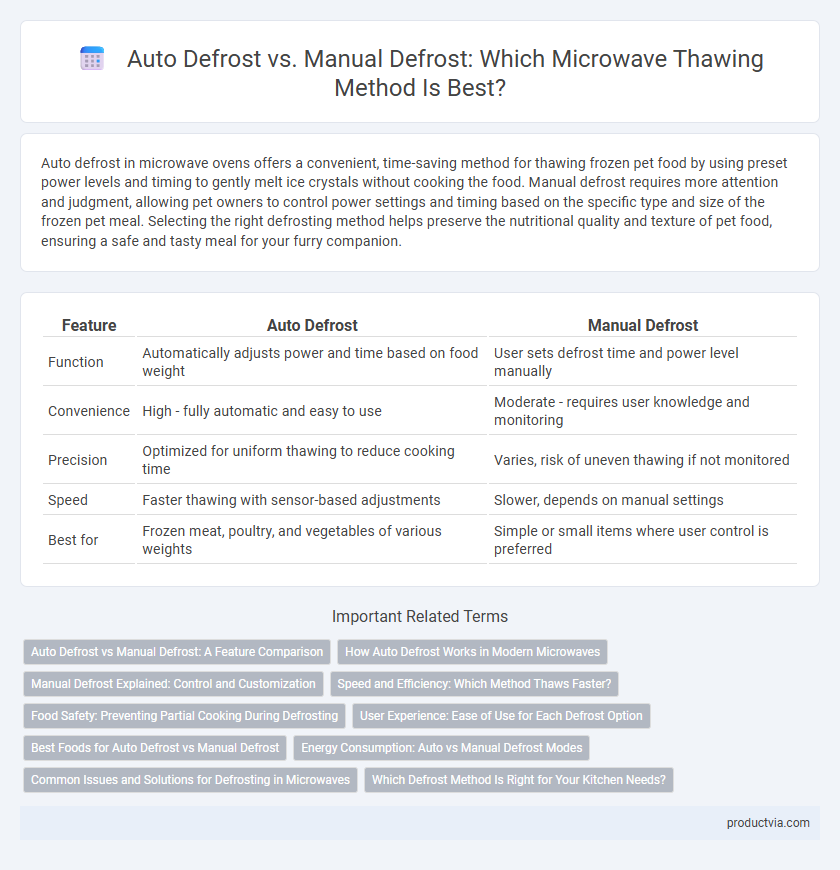Auto defrost in microwave ovens offers a convenient, time-saving method for thawing frozen pet food by using preset power levels and timing to gently melt ice crystals without cooking the food. Manual defrost requires more attention and judgment, allowing pet owners to control power settings and timing based on the specific type and size of the frozen pet meal. Selecting the right defrosting method helps preserve the nutritional quality and texture of pet food, ensuring a safe and tasty meal for your furry companion.
Table of Comparison
| Feature | Auto Defrost | Manual Defrost |
|---|---|---|
| Function | Automatically adjusts power and time based on food weight | User sets defrost time and power level manually |
| Convenience | High - fully automatic and easy to use | Moderate - requires user knowledge and monitoring |
| Precision | Optimized for uniform thawing to reduce cooking time | Varies, risk of uneven thawing if not monitored |
| Speed | Faster thawing with sensor-based adjustments | Slower, depends on manual settings |
| Best for | Frozen meat, poultry, and vegetables of various weights | Simple or small items where user control is preferred |
Auto Defrost vs Manual Defrost: A Feature Comparison
Auto defrost in microwaves uses preset algorithms to detect food weight and automatically adjust thawing time and power for efficient, even thawing, reducing the risk of partially cooked edges. Manual defrost requires users to input specific time and power settings based on food type and weight, offering more control but demanding more attention to prevent uneven thawing or overheating. Auto defrost enhances convenience and consistency, while manual defrost provides flexibility for customized thawing needs.
How Auto Defrost Works in Modern Microwaves
Modern microwave ovens utilize sensor-based auto defrost systems that detect moisture and temperature levels within the food to automatically adjust power levels and defrost time. These sensors optimize thawing by cycling between low and medium power settings, preventing partial cooking while ensuring even heat distribution. This technology reduces user guesswork and preserves food texture by maintaining precise control over the defrosting process.
Manual Defrost Explained: Control and Customization
Manual defrost in microwaves offers precise control over thawing time and power levels, allowing users to customize settings based on the type and weight of food. This method prevents partial cooking often seen with auto defrost functions, ensuring even thawing and preserving texture and flavor. Users benefit from the ability to manually adjust defrost cycles to match unique food requirements, enhancing overall cooking quality.
Speed and Efficiency: Which Method Thaws Faster?
Auto defrost in microwaves uses preset power levels and sensor technology to thaw food quickly and evenly, often reducing thawing time by up to 50% compared to manual defrost. Manual defrost requires the user to adjust power settings and time, which can be less efficient and may result in uneven thawing or partially cooked edges. Overall, auto defrost offers faster and more efficient thawing, optimizing energy use and preserving food texture.
Food Safety: Preventing Partial Cooking During Defrosting
Auto defrost in microwaves uses programmed power levels to evenly thaw food, reducing the risk of partial cooking and bacterial growth. Manual defrost requires careful monitoring and adjusting power settings to prevent hot spots that can lead to uneven thawing and potential food safety hazards. Choosing auto defrost minimizes the chance of overheating edges while keeping the center frozen longer, promoting safer thawing.
User Experience: Ease of Use for Each Defrost Option
Auto defrost in microwaves offers a hassle-free experience, automatically adjusting power levels and time to evenly thaw food without guesswork, saving users time and effort. Manual defrost requires users to input settings and monitor progress closely, which can lead to uneven thawing or partial cooking if not carefully managed. Auto defrost's convenience and precision make it the preferred choice for users seeking a straightforward, user-friendly thawing experience.
Best Foods for Auto Defrost vs Manual Defrost
Auto defrost in microwaves is ideal for evenly thawing delicate foods like poultry, fish, and ground meats without partial cooking, ensuring safe and consistent results. Manual defrost suits denser items such as roasts, whole cuts of beef, or baked goods where precise control over thawing time prevents texture loss or uneven thaw. Selecting the appropriate defrost method enhances food safety and preserves quality by matching the microwave's power settings to the specific food type and thickness.
Energy Consumption: Auto vs Manual Defrost Modes
Auto defrost mode in microwaves typically consumes more energy because it operates in several short bursts to evenly thaw food, using sensors to adjust power levels continuously. Manual defrost requires setting time and power manually, often leading to longer thawing times but potentially lower overall energy use if monitored closely. Choosing manual defrost can reduce energy consumption by eliminating unnecessary power cycling, though it demands more user attention to avoid inconsistent thawing.
Common Issues and Solutions for Defrosting in Microwaves
Microwave auto defrost often causes uneven thawing due to inconsistent power distribution, leading to partially cooked edges and frozen centers; using shorter defrost intervals with frequent checking helps mitigate this issue. Manual defrost requires user attention to set correct time and weight, and errors here can result in over or under-thawed food; consulting the microwave's defrost chart ensures accurate settings and better results. Both methods benefit from rotating the food periodically and separating frozen pieces to promote uniform thawing and prevent bacterial growth.
Which Defrost Method Is Right for Your Kitchen Needs?
Auto defrost in microwaves uses sensor technology to evenly thaw food by automatically adjusting power and time, making it ideal for busy kitchens seeking convenience and precision. Manual defrost allows users to control time and power settings, offering versatility for specific food types and portion sizes, preferred by cooks who want hands-on control. Choosing the right defrost method depends on your cooking habits, food variety, and desired level of control during the thawing process.
Auto Defrost vs Manual Defrost for Thawing Infographic

 productvia.com
productvia.com